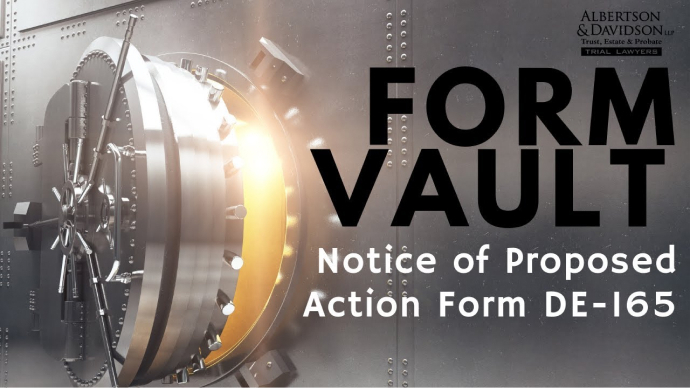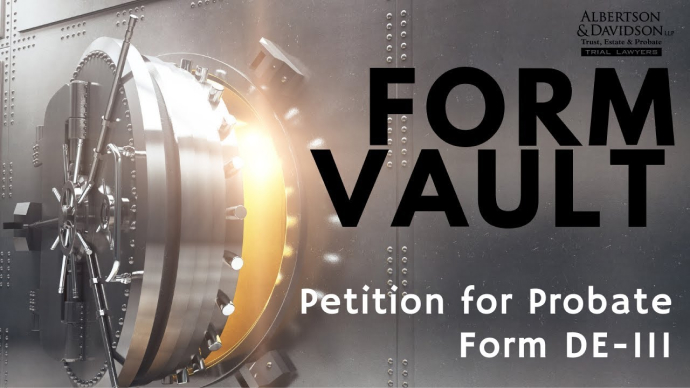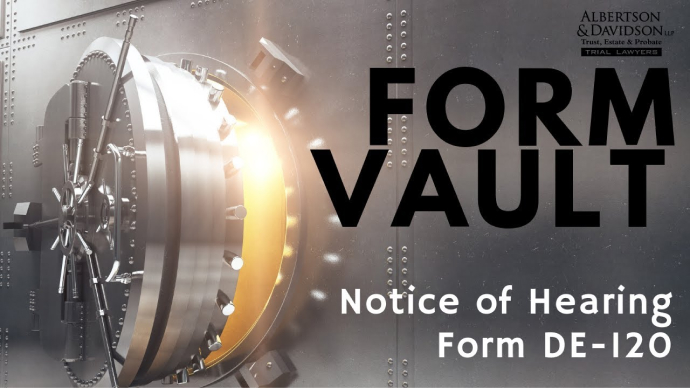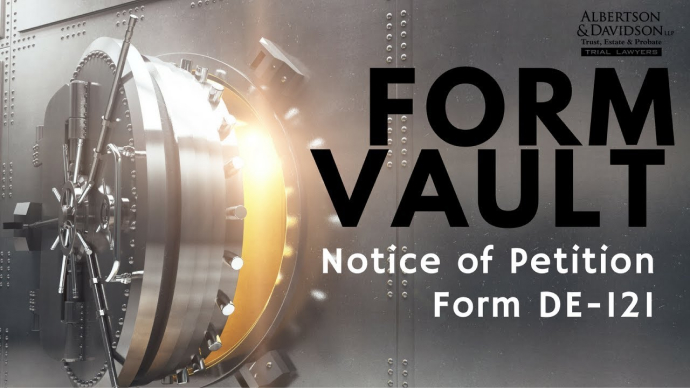Video Transcript
The following is an unedited, verbatim transcript of our video. It is not intended to be a stand-alone article.
Hi, this Keith Davidson of Albertson & Davidson. In this video, I’m going to be going over the Notice of Proposed Action. And this is the personal representative’s best friend to try and stay out of hot water when you’re taking certain actions in a probate estate.
So let’s start by going to Google, and we’ll type in judicial council forms and we’ll go to the court’s website. We’re going to select Probate – Decedent’s Estates, those be the form that we want to use, and we’re going to go down to DE-165.
DE-165
Now, a Notice of Proposed Action is something that a personal representative can do to give notice to all the beneficiaries that they’re going to take some actions, so if they’re going to sell a house, if they’re going to compromise on a claim, if they’re going to purchase an asset, all of that could potentially be the subject of a future lawsuit if the beneficiaries object to that action later in the future. So rather than the executor or the personal representative taking an action and having the beneficiaries sue them about it later, instead, they can give notice ahead of the time that they’re going to take the action, and then the beneficiaries can either agree to it and consent, or they can give their written objection and the personal representative will know that there’ s problem. So for example, if they’re going to sell a house, it’d be good to know before the house sale goes through that somebody has a problem of the house sale, because if the personal representative sells it, and then later they’re sued on it, then they have to deal with the lawsuit, but what’s done is done in terms of the house sale. Whereas if the executor can notify everybody ahead of time, this is what I’m doing, this is how much I’m selling the house for, these are the terms of the sale, then everybody can either agree or disagree before the sale goes through and before the damage is done.
So this all starts off by the attorney for the personal representative filling out their name or if the personal representative is representing themselves, which technically they’re not supposed to do but it does happen, then you would just put in here your name and type pro per after it. And then you have to put in attorney for, so in our example I’m representing Tina Smith, and we’re going to put in the court information where this probate is pending, and you can just go to the court’s website to find these information, you need the street address and the mailing address. Obviously, if you’re in a different county, you’d put in that information, and you want to put in the branch name if you know it, if you don’t, go to the website and find it, and if you can’t find it there, then you can leave that information blank.
This is going to be the Estate of Bob Smith and you want to make sure that you put in the correct case number.
Notice of Proposed Action
And now, we’re to get to the Notice of Proposed Action. Now, right now, there’s not on objection or consent because we’re just going to do the actual notice. So number 1, the personal representative of the estate of the deceased is, so you’re going to put in the name. And the personal representative has the authority to administer the estate without court supervision, if that’s true, under the Independent Administration of Estates Act, then you’ll either going to say if it’s full authority or limited authority. You’ll know which one it is by going back and looking at the Letters of Administration. So if you go back and look at the Letters then you’ll know which one to check, usually, it’s full authority.
Now this is where you’re going to give notice. You have two options, number 3 is for any other options that don’t have to do with a real property transaction. So you’re going to put in a date here. So, you’re going to tell everybody that on or after a certain date, the personal representative is going to take a certain action. And that’s the whole point of this, is you want people to have some time to either consent or object to this action. So we’re going to choose a date. And you can say that the proposed action is described in an attachment labeled attachment 3, that’s usually the best way to do than rather to squeeze it in here, and I’ll just type in “See Attachment” so people know that there’s an attachment to look at.
No.4 – Real Property Transaction
When it come to number 4, if it is a real property transaction, you’re going to check this box, you still have to describer in item number 3 the terms of the transactions, but you also have to list the value of that property in the inventory and appraisal, so that’s where you would actually list out what it was appraised at. So let’s say it was appraised at $500,000.00, you’d put that, if it hasn’t been appraised yet, you’d say “No inventory yet”. That’s a bad idea, you shouldn’t really be selling a real property until it’s been inventoried and appraised. But is that’s the case, then can check that box. It’s better to have it appraised first, so you as a personal representative can prove that you’re selling it at a fair price. And then you’re still going to describe the terms of the real property transaction under number 3. So you have to give things like the sale price, how is the real estate agent going to receiving commissions. You want to disclose as much information as you possibly can. Because the more you disclose, the more you as a personal representative will be protected in the future from any claims of wrongdoings.
Objections
So then you can see down here that it actually tells the beneficiaries that “if you object to the proposed action”, then you’re supposed to sign the objection form below, and you’re supposed to mail it to the personal representative at the following address. So this is where you would specify where any objection should be mailed out to if somebody’s going to object. “Or they can send their own written objection to the address in line 5a”, meaning that they can have their own hand drafted objection if they don’t just want to sign the form, although that’s not really necessary, you can just object down below. You can also “apply to the court for order preventing the personal representative from taking this action”. So, just because there’s an objection doesn’t necessarily mean that the personal representative can’t take that action, it just puts the personal representative on notice that there’s going to be trouble.
So the personal representative is the one that ultimately is going to sign this form, or the attorney for the personal representative, so that information would go here. You also could specify under number 7 if somebody needs more information, who they should call, the name and telephone number that they should call to get more information, that’s important.
And then down here you can see that the beneficiaries can either object by checking the box, or they consent, they can consent by checking that box. And the great thing about consenting is you don’t have to wait until the date that was listed about. So, on our example, we said that we’re going to take an action on December 15, 2018. But if we get a consent from everybody before that date, then the personal representative knows that they can go ahead and take that action, they can finish the real estate transaction, they can do whatever it is that this notice is about.
So that’s how you fill out a Notice of Proposed Action. These forms are really useful for personal representative, it will keep the personal representative out of hot water, it will also give the beneficiaries full disclosure of what the personal representative is going to and the actions are going to take, and it also gives the beneficiaries a chance to voice their objection or their consent to that action before the action is taken, which can be very valuable because once an action is taken, sometimes the damage is already done. Whereas if you can voice an objection prior to the action being taken, maybe you can avert disaster and prevent something from happening.




